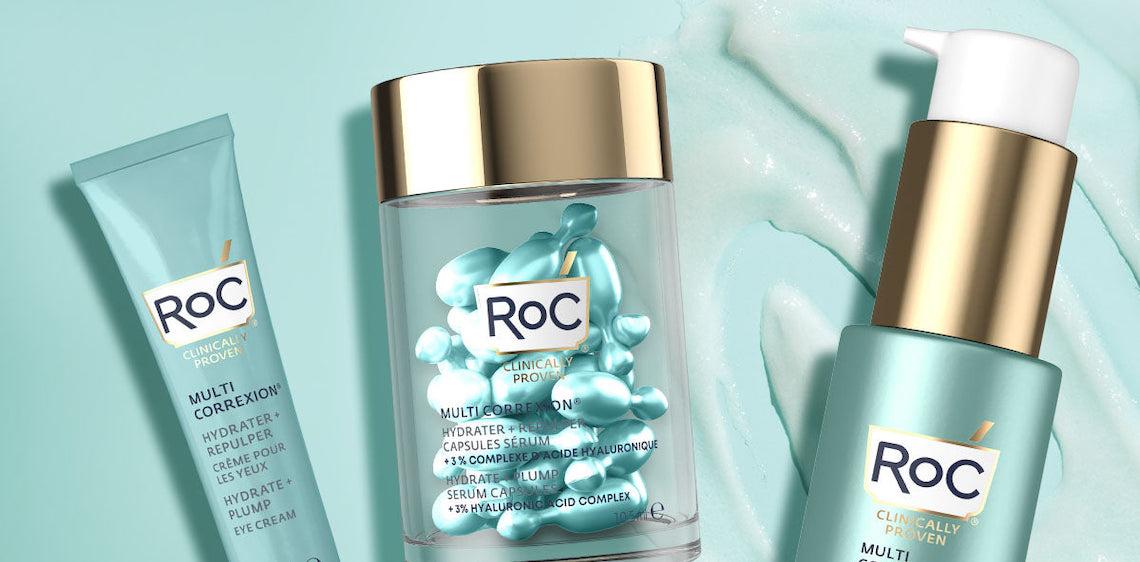As a 65-year-old mass brand, RoC Skincare is out to prove that getting older does not have to be an anxiety-inducing experience.
Formerly owned by Johnson & Johnson and acquired by private equity firm Gryphon Investors in Jan. 2019, RoC Skincare has undergone a transformation as it attempts to reimagine itself for modern consumers. Over the last three years, the brand relaunched its products worldwide in new packaging, expanded the brand into new markets like Canada and China, reignited product development, and invested in social media and DTC e-commerce. RoC also partnered with Sarah Jessica Parker in June for its Look Forward Project, a new brand purpose to mission the power of optimism and its scientifically-backed impact on long-term health and wellbeing. In September, the brand launches two new products, a serum and neck cream, as part of its newer Derm Correxion line, aimed at people between their 30s and 50s.
Over 50% of RoC consumers are under 54 years old. Hillary Hutcheson, CMO of RoC Skincare, said a larger pool of customers in their 20s have been buying into the brand since 2019. Currently, over 30% of the brand’s sales are online through retail partners and the brand’s direct channels, said Fernando Acosta, CEO of RoC Skincare. RoC Skincare products are priced from $12-$39 and are sold at retailers like Target, CVS and Walmart. Terms of the deal were not disclosed in 2019, but according to WWD, industry sources estimated RoC earned roughly $100 million in annual retail sales.
“We attribute this [young customer] trend to a couple of different dynamics,” said Hutcheson. “One is the Zoom Boom and earlier interest in anti-aging categories. Younger consumers buy into the brand through our Vitamin C serum and hyaluronic acid serums. TikTok has been a recruitment area for us, as well.”
As part of its Look Forward Project, RoC published a survey with over 600 women in the U.S. and France on their perceptions of aging, and found that 90% of women feel anxious about getting older, with the No. 1 driver of anxiety being aging appearance. In fact, 60% of participants were more concerned with their aging appearance than about financial stability in retirement. The first stage of the initiative is launching a landing page on RoC’s website detailing the brand’s survey results and scientific facts about the health behind optimism. Dr. Michelle Henry, MD, and Dr. Daisy Robinton, Ph.D., are featured on the landing page. In 2023, RoC will expand its messaging in-store and via wholesale partners.
Establishing itself as a pro-aging brand, or as a beauty brand emotionally supportive of its consumers, is part of a larger shift in the beauty industry over the last decade. Brands like Tula have sought to do away with terms like “anti-aging,” in favor of “ageless,” while Ulta Beauty recently launched a television and digital campaign called “Beauty&” to show how beauty can be a force for good. It is a stark turn from the shaming language and visuals brands have employed in the past to stigmatize aging. Admittedly, there is a certain irony that, although RoC wants to promote aging as an optimistic experience, what drives young customers to the brand is that precise anxiety over aging, which the brand wants to address.
Moreover, the advertising industry at large is still underserving older customers. A 2021 AARP study found that 62% of older people feel ads have an unrealistic representation of people past their 50s, and 47% agreed that “ads of people my age reinforce outdated stereotypes.” Furthermore, women still face the brunt of this misrepresentation. A 2018 study from media agency UM found that 44% of British women age 50 and older found advertising to be patronizing, with 27% feeling ads contribute to negative stereotypes of their age group.
RoC drove new and existing customers to the landing page through a 12-person paid Instagram influencer campaign led by Parker. RoC also sent an undisclosed number of mailers to unpaid influencers, receiving back nearly 1,000 posts across TikTok and Instagram.
Hutcheson declined to share investment figures but said investment into the brand has remained “steady” since the 2019 acquisition and that RoC has refocused its awareness levers into social media marketing and programmatic advertising. RoC invests in linear TV ads and has tapped into retailer partners’ CRM databases for email marketing.
“The population is living longer, and yet they have this anxiety and pessimism about living and getting older. So we want to make sure that we spark relevant conversations about the different life stages you go through,” said Acosta. “We want to lead the conversation on [skin] aging, and the business impact will be a significant increase in brand awareness.”




